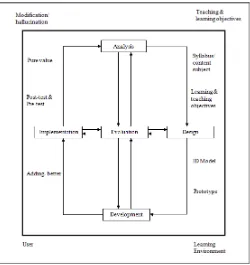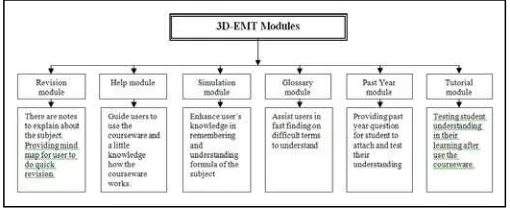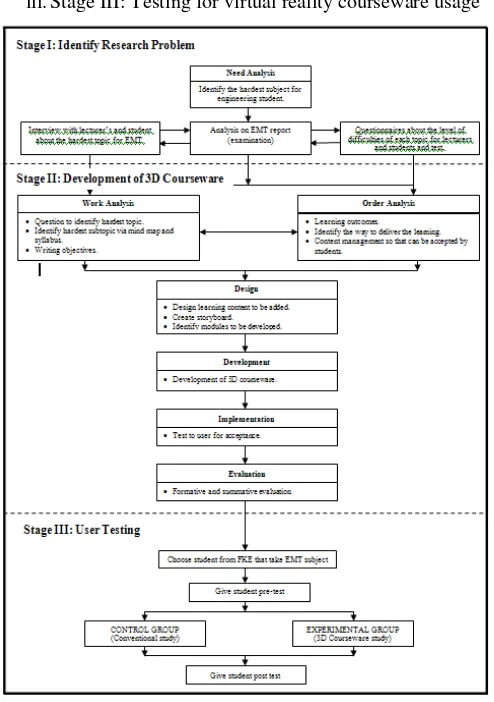A conceptual framework for the design of a 3D
courseware on electromagnetic theory
Norshahidatul Hasana Ishak, Norasiken Bakar, Shahdan Md Lani, Sazilah Salam, Faaizah Shahbodin Faculty of Information and Communication Technology
Universiti Teknikal Malaysia Melaka
Hang Tuah Jaya, 76100 Durian Tunggal, Melaka, Malaysia [email protected], [email protected]
Abstract— This paper will explain about research on development of three dimensional (3D) courseware for Electromagnetic Theory Subject (EMT) subject that have been offers to all Malaysia Technical University Network (MTUN). The EMT courseware was included a multimedia software, three dimensional environment, and exercises for student to be done to test their understanding after using the courseware. Moreover, this paper explain about the research methodology that include the development of the courseware for teaching and learning, the effectiveness of the 3D courseware for teaching and learning, and the use of ICT in education for universities level. In this research it is use of Constructivism-Cognitive-Contextual Model Life Cycle (C3MLC) model to construct the research, which it includes of Analysis phase, Design phase, Development phase, Implementation phase, Evaluation phase. After the first three phases have been completely done, courseware will be test to Subject Matter Expert (SME) to judge the validity of the courseware for the learning usage. It includes past students and lecturers before the Evaluation phase be done to collect research sample, instrument, and methodology of collecting and analyzing data gathered.
Keywords-component; 3D courseware, EMT subject
INTRODUCTION
This paper is about to develop a courseware that will be focus to Universiti Teknikal Malaysia Melaka (UTeM) students who are from Faculty of Electrical Engineering (FKE) and Faculty of Electronics and Computer Engineering (FKEKK). Besides that, not only student can use this tool, but lecturer also can use this tool to teach their student and to do revision. This courseware will develop for subject Electromagnetic Theory (BEKP 3553), however it is not develop for the whole subject, and only one topic will be cover, which is Vector Calculus. The whole chapter will be animated by using multimedia elements, but the main sub-topic will be focus is coordinate system and transformation. This sub topic will be developing using 3D approach. The main purpose on developing this courseware is it focuses on explaining the constant-coordinate surface in the object using 3D environment.
This approach has been chosen which 3D environment is because it will help students who are not interested in study through text but they can learn more on using symbols. Besides that the multisensory nature can be helpful to students especially who are less visual learners [1]. Because of this reason, the related of using virtual reality with education is good in learning because it is enables first person experience.
Another problem of physical education is the poor teaching effect. With the Computer Graphics, emulation technique, multimedia, artificial intelligence technology (AIT), computer networking technology(CNT), parallel processing and multi sensor technique, VR technique simulate human's sense organ function, such as vision, hearing and touch to create a human-based many-dimensions information space which can help the students to immerse in the virtual world when they feel the sports and real time interact with it through the natural way such as language and gesture [2].
Applying ICT in teaching and learning can be seen through some activities such as general software application usage for fetching documents, proposal making, and use of Internet to find information as references or downloading either freeware or shareware as information collaboration [3]. By using the ICT in teaching and learning, it can enhance on conquering ICT in people. So it should be implemented widely in higher institutions in line with developed country that required public as wake technology. It is hoped with the existence of this e-learning by using ICT concept, country's quality of education will be rising and also productivity for one organization are going to pick up through training [4]. Indirectly national vision in effort increase rate wakes as much as IT a little going to succeed in this nearest period.
PROBLEM STATEMENT
this 3D Virtual Environments (VEs) can help people in learning through direct experience by visualizing concepts and performing tasks in a reproduction of the real world or in completely fictional worlds that are suited to the learning task [6].
From the research that have been done, it is found that learning using 3D environment approach have high potential to situate learner within a meaningful context to a much greater extent than a traditional interactive multimedia environment [7]. Combination of virtual learning with the 3D environments’ support teaching and learning in an educational context, offering the functionality to manage the presentation, administration and assessment of coursework [8]. This is because the effect gathered from this situation will leave look and feel concept.
Conventional study is less attractive and interactive; it will make students feels boring easily, besides it is old style of study. They will not get any feel while using conventional study, they just can read, write and memorize. Personal experience in 3D virtual learning environment is more convincing than an empty abstract preaching in traditional places of learning. Favorable designed learning environments would enhance the learning effectiveness [9].
Besides that, the used of the technology gadget also make students becomes more successful because it is really helpful in generating ideas and developing creativity. Generally, technology helps in making teaching and learning become more fun, learning competing and full of information, [10].
The educational benefit of these applications which referring to 3D and virtual reality is the active participation of students in learning process. Moreover, students can observe or carry out virtual exercise and training which will make them feel better while learning, which are either difficult to be performed in a physical classes [11]. The effects of 3D in learning are really powerful as it will give students feel the true learning by using 3D.
With the full blown use of 3D in almost everything in the media nowadays, there’s no escaping the need of utilizing 3D in new educational systems. The students will definitely be yearning for such engaging and dynamic media such as 3D to add some depth to their traditional studying and learning method [12].
RESEARCH OBJECTIVES
Based on the literature review and the preliminary analysis that have been done, there are three objectives will be done for this research which first is the purpose of this research is to identify the effectiveness of 3D elements used in the 3D-EMT courseware to absorb the science process in EMT subject. It is to see does the 3D-EMT courseware will leave positive impact in science skills through the design and development of the courseware. It is not only for students but also for lecturers.
The second objective is the exploration to 3D-EMT courseware is the most important purpose of this research because it will focus on the effectiveness of 3D environment
to their study. The goal of this courseware is to make student understand about the electromagnetic theory.
The final objective is to expose the subject and the users of the courseware to the knowledge that based on the ICT usage.
PROBLEM DEFINITION
One of the research method has been apply while doing the analysis which are few questionnaires have been given to the student that already took this subject and face the examination. Questionnaires given to all four MTUN universities, with the total of students are 176 student that have been took the subject and 8 lecturers for EMT subject to completed the analysis. The question is about the opinion of them on the EMT subject. Respondents will marks their opinion based on Likert Scale that already applied in the questionnaires. The scale is from 1= Easy, 2 = Hard, 3 = Harder, and 4 = Hardest.
The result shows mean of difficulties of topics according to students and lecturers. Both of respondense quote Coordinates System and Transformation as the most hardest topic to learn and to teach, it shows that student mean is 2.74 while lecturers is 3.00. Table 1 shows the most difficult topic in EMT subject through students view while Table 2 shows the most difficult topic in EMT subject through lecturers view. Besides that, to prove that it is the hardest topic, EMT question that covers the whole topics has been given to the student, and it shows the same results, which are most of them cannot answer the question from Constant-Coordinate and Transformation. All the data is analyzed using SPSS. Table 3 shows the results of the EMT test from student.
In Figure 1, is a chart that shows students opinion about tools should be implemented to make learning EMT easily. These results were gathered by students who took EMT subject from all MTUN universities in Malaysia.
TABLE1
THE MOST DIFFICULT TOPIC IN EMT FOR STUDENT
Most Difficult Topic Student
(n = 176) Coordinate system and transformation 2.74 Wave equation in good conductor 2.71 Wave propagation in Lossy Dielectrics 2.66
TABLE2
THE MOST DIFFICULT TOPIC IN EMT FOR LECTURER
Most Difficult Topic Lecturer
(n = 8) Coordinate system and transformation 3 Calculus in Electromagnetic Application 2.75 Gauss’s Law, Biot-Savart’s Law, Magnetic forces, Boundary condition, Faraday’s Law, Transformer & Motional electromotive forces
2.50
Fig. 1. Students view on using multimedia tool in learning Electromagnetic Theory EMT subject
A)3D-EMT courseware development for teaching and learning of Electromagnetic Theory subject for engineering student.
i. Define methodology for 3D-EMT courseware content for Electromagnetic Theory subject.
ii. Creating instructional model (ID Model) for 3D-EMT courseware content of 3D-EMT subject.
iii. Develop prototyping the content for 3D-EMT courseware.
B)Do a research on the successfulness of 3D-EMT courseware among engineering student at UTeM in one case study.
i.Testing the ability of 3D-EMT courseware compared to conventional study in EMT subject (coordinate system and transformation).
ii.Testing the effect of using 3D-EMT courseware in the science process in the EMT subject.
iii.Test the effect of the achieving student used the 3D-EMT courseware based on pre test and post test. CONTRUCTIVISM-COGNITIVESS-CONTEXTUAL MODEL LIFE
CYCLE (C3MLC)
The development of 3D-EMT courseware are based on C3MLC model by Rozie Ezrinda [13] which the model was adapted from the KHGK2 model, Roziah Abdullah, that inspired by waterfall model, will give the inner and outer entity for the education needed so that there is an expanded in terms of cognitive, affective and psychomotor. There are five phases involved in the model which are: analysis, design, development, implementation and evaluation.
Fig. 2. Constructivism-Cognitivess-Contextual Life Cycle (C3MLC)
During the research, the researcher focuses on Design phase, which consist of the design of the 3D-EMT courseware and its content.
In the Design phase, it involves: • Learning outcome
• Teaching & Learning content • Problem or Contains
• Pure value • Evaluation
Figure below, shows the works done in the Design phase. Question
No
Learning Outcomes
Student's Answer
TRUE(%) FALSE(%)
1 Vector Calculus 44.32 55.68
2 Vector Calculus 33.52 66.48
3 Vector Calculus 18.75 81.25
4 Vector Calculus 12.5 87.5
5 Electrostatics 41.48 58.52
6 Electrostatics 25.57 74.43
7 Electrostatics 23.86 76.14
8 Electrostatics 46.02 53.98
9 Magnetostatics 72.73 27.27
10 Magnetostatics 28.98 71.02
11 Magnetostatics 32.39 67.61
12 Magnetostatics 36.36 63.64
13 Wave Application 38.07 61.93
14 Wave Application 15.91 84.09
15 Wave Application 14.2 85.8
Fig. 3. Constructivism-Cognitivess-Contextual Life Cycle (C3MLC): Design Phase
In this phase also, the development of the 3D courseware is based on the outcome of the EMT learning. There are few things that should take serious in this design phase, such as:
(i) Learning content that follows the learning outcome.
(ii)Learning outcome that can be measured. (iii) Best strategy to deliver learning content.
(iv) Student can measure their own self performance.
(v)Student ability to relate and applicant learning source that gathered from the 3D courseware.
Instructional Design Model
ID model for the development of 3D-EMT courseware in educational for the EMT subject based on technology integration. The core of teaching and learning process based on teaching theory and pedagogy.
The purpose of the model to increase the knowledge of Constant Coordinate and Transformation high level thinking skills and scientific skills within the student of the Physics science.
The development of the model based on educational environment such as:
a. Physics approach for this subject.
b. Learning modules includes in the courseware. c. Learning sequence.
d. Teaching and learning through multimedia as delivery.
e. Learning approach
Fig. 4. Instructional Design Model (ID) for 3D-EMT courseware
Learning content that have been added in the courseware are Revision modules that include Notes and Mind Map, Help module, Simulation module, Glossary module, Past Year module, and Tutorial module. Below are the details about each module.
Fig. 5 3D-EMT courseware modules
VI.THEORITICAL FRAMEWORK MODEL
This research framework is used to test the development and the usage of the 3D courseware for Electromagnetic Theory subject. It’s including research questioning and research hypothesis. To achieve the purpose of research, some research question and research hypothesis is designed as below:
RQ1. Does 3D-EMT courseware leave impact in absorbing science skills process?
RQ2. Does the courseware with 3D environment will give good results compare to conventional study?
H0 1: There are no differences between pre-test and
post-test for control group.
H0 2: There are no differences between pre-test and
post-test for experiment group.
H0 3: There are no differences performances among
VIII.REFERENCESS RQ3. How courseware can give impact on using IT in
learning?
H0 4: There is impact on exposing of IT while using
courseware. [1] N. Strangaman, T. Hall (2003). Virtual Reality/Computer Simulation. National Center on Accessing the General Curriculum. 2 – 4.
[2] L. Daduo, L. Rongwei, S. Zhanfeng, L. Ji’an , and C. Chao, “The Application of Virtual Reality in the Practice Course of Physical Education,” ICDLE, pp 76, 2010.
This framework can be seen in Figure below, and it has three stages. The stages are:
[3] S.M Razali (2010), Visualisasi dan Animasi dalam Pengajaran dan Pembelajaran Teknologi Elektrik on Pembangunan dan Penilaina Perisian Kursus Multimedia, 101.
i. Stage I: Identify research problem
ii. Stage II: Development of virtual reality courseware
[4] Majalah PC (2011), E-Learning kaedah pembelajran yang berkesan. Available:
http://pmr.penerangan.gov.my/index.php/component/content/article/94-perisian/303-elearning-kaedah-pembelajaran-yang-berkesan.html iii.Stage III: Testing for virtual reality courseware usage
[5] Matthew N. O.SADIKU (2008). Elements of Electromagnetics. 4th Edition
[6] L. Chittaro and R. Ranon, “An Adaptive 3D Virtual Environment for learning the X3D language,”IUI, 2008.
[7] Barney D., John H. (2001). 3D Learning Environments in Tertiary
Education. Available:
http://www.ascilite.org.au/conferences/melbourne01/pdf/papers/dalgarn ob.pdf
[8] MJ. Callaghan, K.McCuster, J. Lopez Losada et al, “ Integrating Virtual Worlds & Virtual Learning Environment for Online Education”, 2009. [9] X. Jiang, C. Liu, and L. Chen, “ Implementation of a Project-Based 3D Virtual Learning Environment for English laguage Learning”, 2010. [10] Harian Metro, ICT Bantu Kecemerlangan Pelajar, 2011.
[11] H.M Abdul Kader, “E-Learning System in Virtual Environment”, 2008. [12] A. Kamsin, M.Y. Abdullah, “The Developmeny of 3D Multimedia
Learning Tool(MLTBS) in Information Communication Technology (ICT) for Teaching and Learning Puposes”, 2006.
[13] Rozie Ezrinda S., Norasiken B., Faaizah S., Sazilah S. Ibrahim A., “Development of Virtual Lab Learning for Chemistry Subject Based on Contstructivism-Contextual Approach”. IEEE, pp 1654, 2010.
Fig. 6 Theoretical Framework Model
VII.CONCLUSIONS


